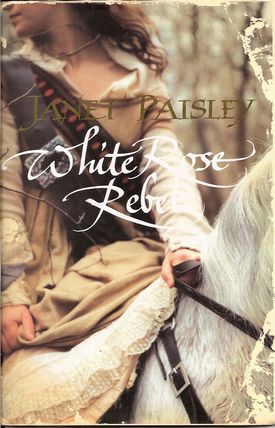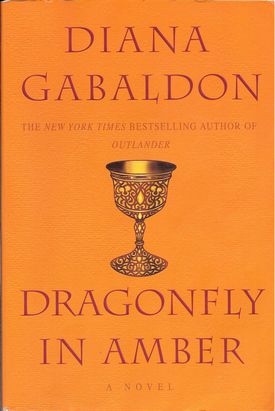Is Waverley Revisted?
Janet Paisley, White Rose Rebel, Viking Penguin [2006] & Diana Gabaldon, Dragonfly in Amber, Delta Random House [1992]
Both these historical novelists forgive HRH Prince Charles Edward for his youthful incompetence, his arrogance and his total lack of personal concern for the Scottish people. But they only do so because they want us to believe that the genocide and cultural persecution his adventure inflicted on the Highlanders and their clan way of life by the Hanoverian monarchy and their ‘Whig’ supporters at and beyond Culloden were perhaps the most potent way to preserve Scottish identity beyond the Act of Union. The pretence Scotland was North Britain, that has continued ever since, is exposed as nothing more than wishful thinking - shared incredibly today by Gordon Brown as the Union’s ‘Whig’ Prime Minister. There were two countries joined in Union in 1707 and in present times one has the far greater sense of identity than the other because HRH Prince Charles Edward provided the opportunity for one to seek to destroy the other. The Auld Enemy remained with Prince Charles the iconic symbol of resistance. The victors went further yet with the reification of tartan and bagpipes as the very essence of Scottish clan life with their proscription for 36 years.
Anne and Claire as the heroines ... with associated Brave-hearts
Both authors intriguingly make women the heroines of their tales. Janet Paisley’s choice of Anne Farquharson, Lady of McIntosh, a principal Lady Rebel in the ’45 by Cumberland’s admission, is inspired because it affords her the opportunity to educate her readers on the fundamental characteristics of clan life and every woman’s equal role therein that was destroyed by the English when clan chiefs were replaced by landlords. Not until Scotland’s reconvened Parliament at Holyrood after 1999 legislated to reinstate community ahead of landlord with a ‘right-to-buy’ and later the ‘right to roam’ have these cultural distinctions been so clearly observable.
In comparison Diana Gabaldon’s Sasannach Claire ‘Randall’ Fraser’s time warp back 200 years from 1945, replete with medical skills honed in World War II does not augur well. She is also engaged in a fruitless strategy to reverse the course of history and save Scotland and her lover from Culloden. But in so doing she accords us great insight into the Prince himself, the early preparations for his adventure in France and the conduct of his campaign from Glenfinnan via Prestonpans, Carlisle, Derby and Falkirk to disaster. Her success in several respects in comparison with Janet Paisley lies in the considerable care she perhaps felt necessary as an American for attention to many historical facts as are known. For instance, here in Prestonpans we will be content she acknowledges the Highlanders presence in Tranent, Anderson [mistakenly named Richard not Robert] offering guidance along the Riggonhead Defile and the patterns of deployment of Cope’s artillery.
Paisley has no role for Anderson replacing him with a beggar girl Catriona that Anne had met in Edinburgh and she has the Highlanders capturing canons before dawn at Prestonpans to turn their fire on the redcoats. Gabaldon however throws away some of her superiority in this respect by suggesting the government forces at Prestonpans under Cope were some 8,000 whereas parity with Prince Charles at approximately 2,000 is the accepted number, and her bizarre rescheduling of events on the eve of Culloden.
But too much historical criticism is unfair since neither pretend to be historians although Claire is married to one in her 20th century persona and Gabaldon herself lives in Scottsdale Arizona. As the novelists they profess to be, newcomer Janet Paisley more greatly impresses with her extraordinarily evocative telling of all three battles in the campaign at Prestonpans, Falkirk and Culloden. In comparison Diana Gabaldon’s 700 + pages of blockbuster story telling are confused with witchcraft accusations arising from her frequently successful attempts to deploy 20th century medical knowledge with only 18th century medicines to hand. Florence Nightingale would however have been greatly impressed with her attention to hygiene and the immediate treatment of shock and wounds. Nowhere is this better illustrated than at Prestonpans where Claire set up medical service points in advance of the battle engagements.
 
Triangulated Love Stories they indeed are!
Both books are love stories, both triangulation of one girl and two boys. Gabaldon’s Claire has the easier time of it since she keeps her two husbands [she wears two wedding rings] 200 years apart although wisely returning with her 18th century pregnancy to the 20th century to give birth much to the consternation of that husband. Anne simply has a lover in Alexander of MacGillivray, then a husband, reverts to the lover but on his death at Culloden eventually returns to her cuckolded husband. Both books have plenty of graphic love scenes with Anne and either her lover or husband achieving the greater enjoyment from the wise pen of Janet Paisley. Claire’s couplings, including the necessary attention of the King of France, are shall we simply say more banal and repetitive. Outside of these relationships, both authors are wont to depict brutal rape and homosexual scenes with their readers.
Paisley’s supremacy as a novelist continues in her exploration of the intra-family and inter-clan loyalties, passions for the Jacobite cause and cynical assessment of risk and opportunity. The plot of White Rose Rebel is the inescapably divergent paths that Anne and her husband, Aeneas McIntosh of McIntosh and Chief of Clan Chatton, must follow. Anne is for the Prince, to achieve ‘Prosperity and No Union’ and rides directly with the clan to Glenfinnan; her husband Aeneas is more circumspect, anxious for the clans lands and their lives if the adventure fails. Many of the significant actors in the real story are carefully characterised. A kindly Cope can be heard placing his bets that his evil successor Hawley too will be defeated by the Highlanders as he was at Falkirk. The Earl of Louden and Lord Justice Forbes are seen as disgusted with the genocide but haplessly committed to the party that is perpetrating it. Aeneas is torn between loyalty to his cuckolding wife as she faces every adversity imaginable including the gallows from which she is eventually saved along with the other three principal Lady Rebels in the ’45 by the wise advice and English scheming of the wife of the most despicable redcoat officer to darken the pages of the book. Diana Gabaldon matches Janet Paisley it must be said however in her descriptive analysis of Claire’s Jacobite husband James Fraser’s encounter with Lord Lovat and his troubled family seeking him to honour his pledge to the Prince to provide men to fight for the cause.
Paisley’s two final scenes capture the essential outcome of the Prince’s adventure. First there is the humiliating acceptance of the domination of the English in the Union Parliament and the Hanoverian monarchy over Scotland exemplified in a beautifully written description of a reception in Anne’s honour given in London by the Duke of Cumberland. The Duke leads her to the floor to ‘dance to his tune’ – his redcoat battle song - only to be challenged before all by Anne to dance also to her’s – The Auld Stuarts back Again. The Duke is bound by good manners to agree but departs reminding Anne “that caper will be your last. Do we understand each other?” and Anne smilingly responds: ”Yes Sir, we do.”
The second is that against this background of London finery her substantive determination is to persuade the Duke to reduce the sentence of 800 lashes imposed on a nurse for aiding the escape of a homosexual Jacobite treasurer that Anne had worked with throughout the campaign. She is successful in this end having been assisted herself in that escape by her husband thereafter reinstated in their marriage bed.
Success already and to come
Diana Gabaldon is a highly successful American historical novelist with six and more titles in similar idiom to her credit. Janet Paisley has only now turned her hand to novelist after contributions in poetry and script writing. It is to be hoped the film or tv rights for her novel are already pledged and that she continues pen in hand to write as she has here.
Both books are well worth reading, with the suggestion that Gabaldon’s Dragonfly in Amber comes first to appreciate the distinctiveness of Janet Paisley’s contribution. They both help us greatly as the Battle of Prestonpans 1745 Heritage Trust deliberately campaigns to honour, evolve and develop the literary inheritance that Victory on September 21st 1745 gave to Scotland.
Janet Paisley offers through Anne a fitting conclusion after Cumberland danced to her tune: that caper “raised hope, hope that was still a spark to be lit that might blaze into tomorrow. A nation did not die when its spirit lived. ….. Laws could be repealed, new ways found to live. Freedom was an idea. It could not be destroyed.”
________________________________________________________
[This review by Gordon Prestoungrange]
Published Date: November 15th 2007
|





